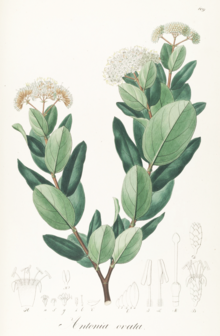Antonia ovata
| Antonia ovata | ||||||||||||
|---|---|---|---|---|---|---|---|---|---|---|---|---|

Inflorescence and leaves of Antonia ovata |
||||||||||||
| Systematics | ||||||||||||
|
||||||||||||
| Scientific name of the genus | ||||||||||||
| Antonia | ||||||||||||
| Pohl | ||||||||||||
| Scientific name of the species | ||||||||||||
| Antonia ovata | ||||||||||||
| Pohl |
Antonia ovata is a species of the nugget family from central to northern South America . It is the only species in the genus Antonia .
description
Antonia ovata grows in the savannah as a smaller shrub or in the rainforest as a tree up to 20–30 meters or a little more high. The trunk diameter reaches 35-50 (60) centimeters. There are smaller roots . The brown-gray bark is slightly furrowed.
The simple, short-stalked and leathery, thick leaves are cross-opposite. The short petiole is up to 1 centimeter long. The leaves are entire, egg-shaped or elliptical to rounded and rounded to indented or rounded. The 4–10 centimeter long leaves are glabrous on the top and partly weakly to slightly hairy on the underside. The veins are pinnate with curved side veins. There are minimal stipules .
Terminal or axillary, small upright double umbels are formed, which usually stand together in twos or threes. There are often sloping bracts on the peduncle as well as on the branches and cones . The fragrant, fivefold and stalked, yellowish to white, off-white, small and hermaphrodite flowers with a double perianth are of some greenish and multi-circuit (3-4), flaky and dachigen bracts ( epicalyx ) highlighted. The free, 4–5 millimeter long, greenish sepals are ciliate. The petals are fused in the shape of a saucer, with recessed to rolled-up, ovoid lobes. The crown is hairy on the inside of the throat and the corolla lobes are about the same length as the 4–5 millimeter long corolla tube. The protruding 5 free stamens with hairy stamens at the base and arrow-shaped anthers are attached in the throat. The two-chamber, above a little hairy ovary is upper constant, with a long pen with capitate, sometimes slightly zweilappiger scar .
Colletera , glandular villi, are formed below in the calyx, in the leaf and bract axils.
Small, two-lobed, septicidal, glabrous and dark brown, about 7–9 millimeters long, elongated capsule fruits with a permanent calyx and outer calyx are formed. They contain 2–4 all around winged, dark brown, flat seeds and they open at the tip with the usually slightly two-part flaps. The seeds with the membranous and slightly transparent wings are 7–8 millimeters long.
Taxonomy
The first description of the genus Antonia and the species Antonia ovate was made in 1831 by Johann Baptist Emanuel Pohl in Pl. Bras. Icon. Descr. 2: 13, 14, t. 109. Synonyms are Antonia ovata var. Excelsa Paula , Antonia ovata var. Glabra ProGel , Antonia ovata var. Pilosa (Hook.) ProGel , Antonia pilosa Hook. and Antonia pubescens bong.
use
The wood is known as Inyak , Inacú or Tamanokware . It is medium weight, moderately resistant and it is used for some applications.
Crushed leaves or the leaf extract can be used as a fish poison or insecticide .
literature
- AM Polak, HR Rypkema: Major Timer Trees of Guyana A Field Guide. Tropenbos, 1992, ISBN 90-5113-013-9 , online (PDF; 8.5 MB).
- Franklin R. Longwood: Present and Potential Commercial Timbers of the Caribbean. Agriculture Handbook 207, USDA, 1962, p. 65 f, limited preview in the Google book search.
- K. Kubitzki , Joachim W. Kadereit , Volker Bittrich: The Families and Genera of Vascular Plants. Vol. XV: Flowering Plants Eudicots , Springer, 2018, ISBN 978-3-319-93604-8 , pp. 511-520.
Web links
- Antonia ovata on plantsystematics.org (pictures).
Individual evidence
- ↑ online at biodiversitylibrary.org.
- ↑ Opender Koul: The Handbook of Naturally Occurring Insecticidal Toxins. CABI, 2016, ISBN 978-1-78064-270-3 , p. 774.
- ↑ AM Polak, HR Rypkema: Major Timer Trees of Guyana A Field Guide.
